Care and Breeding of Feeders
3 posters
Page 1 of 1
 Care and Breeding of Feeders
Care and Breeding of Feeders
The Keeping & Breeding of Meal Worms (Written by Jolene)
Introduction to Meal Worms
Mealworms are the larval form of the mealworm beetle, Tenebrio molitor, a species of darkling beetle. Like all holometabolic insects, they go through four life stages: egg, larva, pupa, and adult. Larvae typically measure about 2.5 cm or more, whereas adults are generally between 1.25 and 1.8 cm in length. Mealworms are typically used as a food source for reptile, fish, and avian pets.
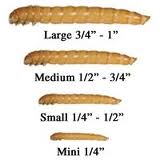
Nutritonal Value
According to one website: http://www.exoticnutrition.com/limein.html, the nutritional value of Meal Worms is as follows:
Fat 27.2%, Protein 49.6%, Carbohydrates 6.9 grams/100, Calories 471 calories/100 grams
How to house Meal Worms: Enclosures, Substrate & Lighting
Most feeder insects can be housed in a ‘cricket keeper’ or a plastic pet carrier. These are plastic containers with a ventilated lid, which usually has a lift-up plastic door. These containers are excellent to housing live foods as they provide adequate ventilation and they can be easily cleaned. They come in a variety of sizes, making them ideal for any size of insect. The sides of the plastic containers are smooth, and Meal Worms cannot climb up smooth, flat surfaces. This means them perfect for housing these worms.
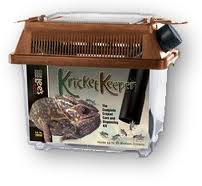
Many people also choose to house their feeder insects in storage bins or large plastic containers, especially if they want to breed their own colony. If you do decide to house your Meal Worms this way, ensure that the lids as been modified to include a mesh screen cover. This will provide the housing with the ventilation require to keep the feeder insects alive and in top condition.
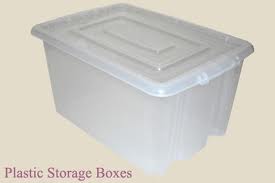
The best substrate to keep Meal Worms in is uncooked rolled oats. I have seen them kept on sand as well but I prefer the rolled oats personally.
No lighting is required for Meal Worms, as they prefer to live in dark places.
How to house Meal Worms: Enclosure Deco, Humidity & Heating
There is no need for meal worms to have any decor in their tank. They need their substrate, food and that is all that is required.Meal Worms prefer a dry place to live so there is no need for misting, nor do they require any water. There is no requirement for heat as the can thrive in most indoor temperatures.
What should I feed my Meal Worms?
Meal Worms, like many other worms, will eat almost all vegetables or fruit. So if you have any fresh vegetables or fruit left over from your meals, give them to your worms. Any vegetable peelings are good, too. Some popular veg/fruit for worms: carrots, romaine lettuce, tomatoes, cucumber, apple and pear. There are a range of commercial live food ‘bug grubs’ available from pet stores. Remember, the point of gut loading your live foods is to make the more nutritious for your reptile, so feed foods that will boost the nutritional value of the Meal Worms.

Breeding Meal Worms
If you are lucky and your worms are just about to pupate when you get them you might have a few pupa in the first week, but most likely it will be 1-3 weeks before you start to see pupa in the box. The pupa look like alien worms, they are shorter, curl into a C shape, and usually wind up on top of your bedding. Your larvae will eat them if you don't separate them out quickly. Check the box at least every 2 days and pull out all the pupa and put them in a smaller box. The box that the pupa are in doesn't need much in the way of food and water, I usually put about 1/2 to 1 inch of bedding in(to make the beetles easier to pick up) and 1/4 of a carrot.
After 1 or 2 weeks the pupa will hatch into beetles, you have to be quick at separating the beetles from the pupa because the beetles will eat them if given too much time. Move the beetles to the other of your smaller containers, this one should have about 1-2 inches of bedding and half a carrot. I've noticed the beetles seem to drink from the carrots the most, so be sure to keep an eye on them. Ive been picking up the beetles by hand and moving them over, if you are the squeamish type, and for some reason are still raising insects you can put an apple in the container, the beetles will grab onto it and you can shake them off into the beetle box.
After you have 10-20 beetles you will want to start separating the bedding in your beetle box from the beetles every 2 weeks. The beetles will eat the eggs if you leave them with the eggs longer then that. To separate the beetles from the bedding you can use a sifter, you want to have the holes be just smaller then the beetles, if its too big it will allow beetles to fall through, too small and it will take forever. An alternate method is putting an apple slice in and waiting for the beetles to swarm it, then shaking them off. Add the separated bedding to your 6 quart worm box. Then add fresh bedding into the beetle box. After a few months you will figure the right amounts to use to keep the bedding amounts constant in your worm box.
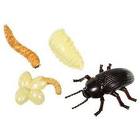
This is the stages of a meal worm life.
Thanks for reading
Introduction to Meal Worms
Mealworms are the larval form of the mealworm beetle, Tenebrio molitor, a species of darkling beetle. Like all holometabolic insects, they go through four life stages: egg, larva, pupa, and adult. Larvae typically measure about 2.5 cm or more, whereas adults are generally between 1.25 and 1.8 cm in length. Mealworms are typically used as a food source for reptile, fish, and avian pets.

Nutritonal Value
According to one website: http://www.exoticnutrition.com/limein.html, the nutritional value of Meal Worms is as follows:
Fat 27.2%, Protein 49.6%, Carbohydrates 6.9 grams/100, Calories 471 calories/100 grams
How to house Meal Worms: Enclosures, Substrate & Lighting
Most feeder insects can be housed in a ‘cricket keeper’ or a plastic pet carrier. These are plastic containers with a ventilated lid, which usually has a lift-up plastic door. These containers are excellent to housing live foods as they provide adequate ventilation and they can be easily cleaned. They come in a variety of sizes, making them ideal for any size of insect. The sides of the plastic containers are smooth, and Meal Worms cannot climb up smooth, flat surfaces. This means them perfect for housing these worms.

Many people also choose to house their feeder insects in storage bins or large plastic containers, especially if they want to breed their own colony. If you do decide to house your Meal Worms this way, ensure that the lids as been modified to include a mesh screen cover. This will provide the housing with the ventilation require to keep the feeder insects alive and in top condition.

The best substrate to keep Meal Worms in is uncooked rolled oats. I have seen them kept on sand as well but I prefer the rolled oats personally.
No lighting is required for Meal Worms, as they prefer to live in dark places.
How to house Meal Worms: Enclosure Deco, Humidity & Heating
There is no need for meal worms to have any decor in their tank. They need their substrate, food and that is all that is required.Meal Worms prefer a dry place to live so there is no need for misting, nor do they require any water. There is no requirement for heat as the can thrive in most indoor temperatures.
What should I feed my Meal Worms?
Meal Worms, like many other worms, will eat almost all vegetables or fruit. So if you have any fresh vegetables or fruit left over from your meals, give them to your worms. Any vegetable peelings are good, too. Some popular veg/fruit for worms: carrots, romaine lettuce, tomatoes, cucumber, apple and pear. There are a range of commercial live food ‘bug grubs’ available from pet stores. Remember, the point of gut loading your live foods is to make the more nutritious for your reptile, so feed foods that will boost the nutritional value of the Meal Worms.

Breeding Meal Worms
If you are lucky and your worms are just about to pupate when you get them you might have a few pupa in the first week, but most likely it will be 1-3 weeks before you start to see pupa in the box. The pupa look like alien worms, they are shorter, curl into a C shape, and usually wind up on top of your bedding. Your larvae will eat them if you don't separate them out quickly. Check the box at least every 2 days and pull out all the pupa and put them in a smaller box. The box that the pupa are in doesn't need much in the way of food and water, I usually put about 1/2 to 1 inch of bedding in(to make the beetles easier to pick up) and 1/4 of a carrot.
After 1 or 2 weeks the pupa will hatch into beetles, you have to be quick at separating the beetles from the pupa because the beetles will eat them if given too much time. Move the beetles to the other of your smaller containers, this one should have about 1-2 inches of bedding and half a carrot. I've noticed the beetles seem to drink from the carrots the most, so be sure to keep an eye on them. Ive been picking up the beetles by hand and moving them over, if you are the squeamish type, and for some reason are still raising insects you can put an apple in the container, the beetles will grab onto it and you can shake them off into the beetle box.
After you have 10-20 beetles you will want to start separating the bedding in your beetle box from the beetles every 2 weeks. The beetles will eat the eggs if you leave them with the eggs longer then that. To separate the beetles from the bedding you can use a sifter, you want to have the holes be just smaller then the beetles, if its too big it will allow beetles to fall through, too small and it will take forever. An alternate method is putting an apple slice in and waiting for the beetles to swarm it, then shaking them off. Add the separated bedding to your 6 quart worm box. Then add fresh bedding into the beetle box. After a few months you will figure the right amounts to use to keep the bedding amounts constant in your worm box.

This is the stages of a meal worm life.
Thanks for reading
Last edited by smsararas2 on Mon Aug 29, 2011 3:27 am; edited 1 time in total
 Re: Care and Breeding of Feeders
Re: Care and Breeding of Feeders
The Keeping & Breeding of Dubai Roaches
Introduction to Dubai Roaches
Dubai Roaches are a popular live food used for reptiles. They are easy to care for, easy to breed, nutritious and large, which is great for larger species of reptile. They are favoured by a lot of herp keepers as they do not smell or make any sounds, like crickets do. They also cannot jump or fly, even though they have wings. Dubai roaches, also known as the orange spotted roach and the Argentine roach, are a large species of insect. Their scientific name is Blaptica dubia. They originate from South America, but are used all over the world as feeder insects. The male and female are sexually dimorphic; this means that they look different and can be easily identified.

Nutritonal Value
According to one website: http://www.theroachguy.com/new_page_1.htm, the nutritional value of Dubai Roaches is as follows:
Moisture: 61%, Protein: 36%, Fat: 7%, Ash 2%
How to house Dubai Roaches: Enclosures, Substrate & Lighting
Most feeder insects can be housed in a ‘cricket keeper’ or a plastic pet carrier. These are plastic containers with a ventilated lid, which usually has a lift-up plastic door. These containers are excellent to housing live foods as they provide adequate ventilation and they can be easily cleaned. They come in a variety of sizes, making them ideal for any size of insect. The sides of the plastic containers are smooth, and Dubai Roaches cannot climb up smooth, flat surfaces. This means them perfect for housing these roaches.
It is recommended that you use a dark coloured tub or cover a clear tub to make it dark for your Dubai roaches, as many breeders have discovered that allowing light into the tank makes the roaches breed much more slowly than if they are kept in the dark.


Many people also choose to house their feeder insects in storage bins or large plastic containers, especially if they want to breed their own colony. If you do decide to house your Dubai Roaches this way, ensure that the lids as been modified to include a mesh screen cover. This will provide the housing with the ventilation require to keep the feeder insects alive and in top condition.

There are various substrates that can be used so it’s up to you which one you choose! Some examples are peat or compost, sphagnum moss, bran bedding, coconut fibre or eco earth substrate, paper towels or newspaper. Anything that is easy to clean and cheap is the best substrate in my opinion. I have seen many live foods kept on bran bedding (2nd pic).
Some people prefer to use no substrates for their dubai roaches, as they produce 'frass'. Frass is a powdery substance that insects will excrete when they have eaten plant material and vegetables. This frass will build up in the container and can be used as a substrate. It is said that 'frass' is essential for baby Dubai Roaches, as the bacteria present in it aids digestive maturity. Look up Frass on google

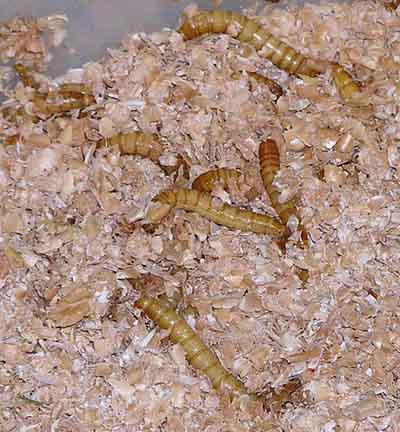
This picture shows 'frass' produced by some caterpillars. All insects produce this, including Dubai Roaches.

No lighting is required for Dubai Roaches, as they prefer to live in dark places.
How to house Dubai Roaches: Enclosure Deco, Humidity & Heating
You can provide any furnishing for your Dubai Roaches as you want. You can use natural deco or simply deco that can be found around the house. Some people recommend filling the enclosure with egg boxes, placed in vertically. This provides shelter and hiding places.
- Some examples of cheap, easy replaceable deco: egg box, toilet roll tubes, cardboard boxes, plastic tubs.

- Some examples of natural deco: rocks, plants, sticks, logs. Flake plants can also be used.
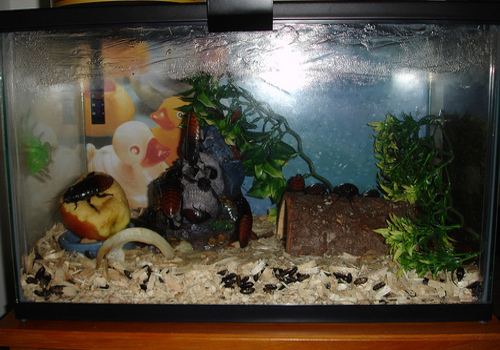
Dubai Roaches prefer an average humid level so it is important that you mist their enclosure once a day, so that the substrate and furnishing are damp, not wet. You should also provide a shallow water bowl for your roaches; fill with water or with water jelly made for feeder insects, tarantulas and other insects, (Polymer crystals, also called polyacrylamide gel, water crystals, water bites). You can also provide water by using a sponge or paper towels. You should spray or soak these and place them in the enclosure, the feeder insects will suck the moisture out.
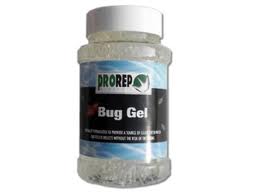

Dubai Roaches require higher temperatures than other feeder insects as they originate from areas with a tropical climate. They require a temperature of 80-85 Fahrenheit, 27°C (81°F) is also recommended. These temperatures allow for optimum health and breeding. They also prefer a temperature gradient, like most herps do, so ensure that you place a heat source at one side of the enclosure, and leave the other cool so that if they can move around depending on their body temperature.
You can use a variety of heating products for your Dubai Roaches. Some examples: heat mat, heat tape, ceramic heat emitter and bulbs or you can place their enclosure in a pre-heated room. All of these heating products should be controlled by a thermostat to prevent the enclosure getting to extreme temperatures in summer and dropping to very cold temperatures in the winter. The thermostat ensures that the heating product is always kept around the same temperature, providing the perfect breeding environment for your roaches.

What should I feed my Dubai Roaches?
Dubai roaches, like many other insects, will eat almost vegetables or fruit. So if you have any fresh vegetables or fruit left over from your meals, give them to your roaches. Insects also like veggies and fruit that are beginning to rot, and they are soft. Any vegetable peelings are good, too. Some popular veg/fruit for insects: carrots, romaine lettuce, tomatoes, cucumber, apple and pear. Oranges are also popular foods for feeder insects, as they provide them with rich vitamins and minerals. These, in turn, provide your herps with the same nutrition

Feeder insects will also eat grain mixes, porridge oats and bread, especially stale bread. There are a range of commercial live food ‘bug grubs’ available from pet stores. Some people choose to feed their roaches’ dried pet food or mashed up meat, it’s entirely up to you what you feed your insects, but ensure to research before you try different foods. People choose to feed high protein cat and dog foods to their Dubai Roaches as that they will be rich in proteins for the reptiles they are being fed to. Remember, the point of gut loading your live foods is to make the more nutritious for your reptile, so feed foods that will boost the nutritional value of the Dubai Roaches.
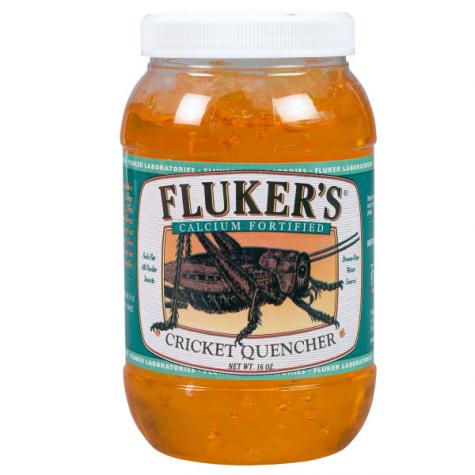

Breeding Dubai Roaches
Dubai Roaches become sexually mature at around 6 months old, and have a life span of 8-10 months in males, 11-18 months in females. As I mentioned before, they are sexually dimorphic, so you can clearly see the difference between the male and the female. Female roaches are bulkier than the males, and grow larger, often exceeding 4.5cm. Males grow to just over 4cm and have larger wings. Females can give birth of 25-35 live young every 2 months, once they have reached sexually maturity. If you are breeding your Dubai Roaches, it is advisable to keep your females for longer so that they can breed, and use your males for feeding your reptiles. The eggs of the female hatch inside her body, giving the impression that she gives birth of live young. Most roaches are ovoviviparous. Google it Young roaches are called 'Nymphs'.
Young roaches are called 'Nymphs'.
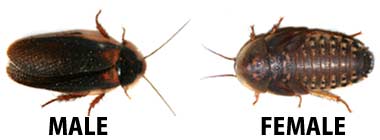
Well, I hope my Dubai Roach caresheet covered everything about keeping and breeding!
Thanks for reading

Introduction to Dubai Roaches
Dubai Roaches are a popular live food used for reptiles. They are easy to care for, easy to breed, nutritious and large, which is great for larger species of reptile. They are favoured by a lot of herp keepers as they do not smell or make any sounds, like crickets do. They also cannot jump or fly, even though they have wings. Dubai roaches, also known as the orange spotted roach and the Argentine roach, are a large species of insect. Their scientific name is Blaptica dubia. They originate from South America, but are used all over the world as feeder insects. The male and female are sexually dimorphic; this means that they look different and can be easily identified.

Nutritonal Value
According to one website: http://www.theroachguy.com/new_page_1.htm, the nutritional value of Dubai Roaches is as follows:
Moisture: 61%, Protein: 36%, Fat: 7%, Ash 2%
How to house Dubai Roaches: Enclosures, Substrate & Lighting
Most feeder insects can be housed in a ‘cricket keeper’ or a plastic pet carrier. These are plastic containers with a ventilated lid, which usually has a lift-up plastic door. These containers are excellent to housing live foods as they provide adequate ventilation and they can be easily cleaned. They come in a variety of sizes, making them ideal for any size of insect. The sides of the plastic containers are smooth, and Dubai Roaches cannot climb up smooth, flat surfaces. This means them perfect for housing these roaches.
It is recommended that you use a dark coloured tub or cover a clear tub to make it dark for your Dubai roaches, as many breeders have discovered that allowing light into the tank makes the roaches breed much more slowly than if they are kept in the dark.


Many people also choose to house their feeder insects in storage bins or large plastic containers, especially if they want to breed their own colony. If you do decide to house your Dubai Roaches this way, ensure that the lids as been modified to include a mesh screen cover. This will provide the housing with the ventilation require to keep the feeder insects alive and in top condition.

There are various substrates that can be used so it’s up to you which one you choose! Some examples are peat or compost, sphagnum moss, bran bedding, coconut fibre or eco earth substrate, paper towels or newspaper. Anything that is easy to clean and cheap is the best substrate in my opinion. I have seen many live foods kept on bran bedding (2nd pic).
Some people prefer to use no substrates for their dubai roaches, as they produce 'frass'. Frass is a powdery substance that insects will excrete when they have eaten plant material and vegetables. This frass will build up in the container and can be used as a substrate. It is said that 'frass' is essential for baby Dubai Roaches, as the bacteria present in it aids digestive maturity. Look up Frass on google


This picture shows 'frass' produced by some caterpillars. All insects produce this, including Dubai Roaches.

No lighting is required for Dubai Roaches, as they prefer to live in dark places.
How to house Dubai Roaches: Enclosure Deco, Humidity & Heating
You can provide any furnishing for your Dubai Roaches as you want. You can use natural deco or simply deco that can be found around the house. Some people recommend filling the enclosure with egg boxes, placed in vertically. This provides shelter and hiding places.
- Some examples of cheap, easy replaceable deco: egg box, toilet roll tubes, cardboard boxes, plastic tubs.

- Some examples of natural deco: rocks, plants, sticks, logs. Flake plants can also be used.

Dubai Roaches prefer an average humid level so it is important that you mist their enclosure once a day, so that the substrate and furnishing are damp, not wet. You should also provide a shallow water bowl for your roaches; fill with water or with water jelly made for feeder insects, tarantulas and other insects, (Polymer crystals, also called polyacrylamide gel, water crystals, water bites). You can also provide water by using a sponge or paper towels. You should spray or soak these and place them in the enclosure, the feeder insects will suck the moisture out.


Dubai Roaches require higher temperatures than other feeder insects as they originate from areas with a tropical climate. They require a temperature of 80-85 Fahrenheit, 27°C (81°F) is also recommended. These temperatures allow for optimum health and breeding. They also prefer a temperature gradient, like most herps do, so ensure that you place a heat source at one side of the enclosure, and leave the other cool so that if they can move around depending on their body temperature.
You can use a variety of heating products for your Dubai Roaches. Some examples: heat mat, heat tape, ceramic heat emitter and bulbs or you can place their enclosure in a pre-heated room. All of these heating products should be controlled by a thermostat to prevent the enclosure getting to extreme temperatures in summer and dropping to very cold temperatures in the winter. The thermostat ensures that the heating product is always kept around the same temperature, providing the perfect breeding environment for your roaches.

What should I feed my Dubai Roaches?
Dubai roaches, like many other insects, will eat almost vegetables or fruit. So if you have any fresh vegetables or fruit left over from your meals, give them to your roaches. Insects also like veggies and fruit that are beginning to rot, and they are soft. Any vegetable peelings are good, too. Some popular veg/fruit for insects: carrots, romaine lettuce, tomatoes, cucumber, apple and pear. Oranges are also popular foods for feeder insects, as they provide them with rich vitamins and minerals. These, in turn, provide your herps with the same nutrition

Feeder insects will also eat grain mixes, porridge oats and bread, especially stale bread. There are a range of commercial live food ‘bug grubs’ available from pet stores. Some people choose to feed their roaches’ dried pet food or mashed up meat, it’s entirely up to you what you feed your insects, but ensure to research before you try different foods. People choose to feed high protein cat and dog foods to their Dubai Roaches as that they will be rich in proteins for the reptiles they are being fed to. Remember, the point of gut loading your live foods is to make the more nutritious for your reptile, so feed foods that will boost the nutritional value of the Dubai Roaches.


Breeding Dubai Roaches
Dubai Roaches become sexually mature at around 6 months old, and have a life span of 8-10 months in males, 11-18 months in females. As I mentioned before, they are sexually dimorphic, so you can clearly see the difference between the male and the female. Female roaches are bulkier than the males, and grow larger, often exceeding 4.5cm. Males grow to just over 4cm and have larger wings. Females can give birth of 25-35 live young every 2 months, once they have reached sexually maturity. If you are breeding your Dubai Roaches, it is advisable to keep your females for longer so that they can breed, and use your males for feeding your reptiles. The eggs of the female hatch inside her body, giving the impression that she gives birth of live young. Most roaches are ovoviviparous. Google it

Well, I hope my Dubai Roach caresheet covered everything about keeping and breeding!
Thanks for reading

Last edited by gothicgurrrl on Wed Aug 31, 2011 12:05 am; edited 10 times in total
 Re: Care and Breeding of Feeders
Re: Care and Breeding of Feeders
Great information. I have a couple of things to add to your Dubia sheet though. I recommend using a dark tub for breeding purposes and filling it with vertically stacked egg crates. Dubia kept in containers that allow light in seem to breed much more slowly. I use no substrate as they create their own "frass". I also use a small under tank heater under one end of the tub to offer a temperature gradient. As for food sources, I use high protein dry dog or cat food, and several different fruits and vegetables. Oranges in particular seem to stimulate breeding and give them hydration. You just have to make sure you don't put in too much, or clean out any leftovers after a couple of days. Mold will kill your entire colony very quickly. I also only clean out my tubs every 6 months or so. The bacteria in the roach "frass" is essential to the babies digestive maturity.
 Re: Care and Breeding of Feeders
Re: Care and Breeding of Feeders
Thanks for great info Shawn 
I will add it into the caresheet now.. I'd never known anything about dubai roaches until I wrote that sheet
I'd never known anything about dubai roaches until I wrote that sheet 
I will add it into the caresheet now..
 Similar topics
Similar topics» Care and Breeding of Dubia Roaches
» What not to use When Gutloading Feeders
» Question on feeders
» What size feeders ???
» Woohoo! New feeders INC!
» What not to use When Gutloading Feeders
» Question on feeders
» What size feeders ???
» Woohoo! New feeders INC!
Page 1 of 1
Permissions in this forum:
You cannot reply to topics in this forum


 Status
Status LGF Points
LGF Points


